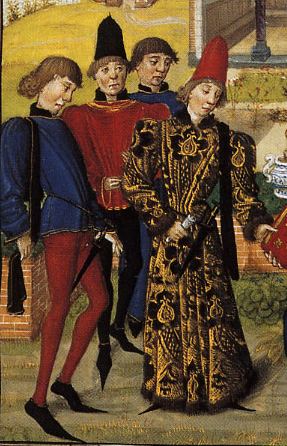 | ||
Crakows or crackowes were a style of shoes with extremely long toes very popular in the 15th century. They were so named because the style was thought to have originated in Kraków, then the capital of Poland. The term Poulaine, as in souliers a la poulaine, "Shoes in the Polish fashion", referred to the long pointed beak of the shoe, not the shoe itself.
Contents
History
Long toed shoes had been popular in Europe at different times, first appearing in the archaeological record in the 12th century and falling in and out of fashion periodically before reaching their most exaggerated form in the third quarter of the 15th century and falling out of fashion in the 1480s.
14th century poulaine-toed shoes found in London were found only in men's sizes, but 15th century art shows them being worn by both men and women, with the toes of men's shoes being the most extravagantly long.
Toe Support
Poulaine toes were packed with stuffing to provide rigidity and help them hold their shape. Surviving examples from medieval London have the points stuffed with moss.
There is no archaeological or medieval iconographic evidence to support the idea that the toes were ever tied up to the leg. The practice is mentioned by the antiquarian John Stow in his 1698 publication A Survey of London, where he wrote:
However, given that John Stow was writing over 100 years after the shoes fell out of fashion, and the lack of rigorous historical research in the writings of the time, he cannot be considered a reliable source. His record of Act 4 of Edward IV is exaggerated - the actual act does mention restrictions in length, but not monetary penalties, parliament or clergy:
Overshoes made from leather or cork, called Pattens, were frequently worn with late medieval shoes both indoors and outdoors. The shape of pattens reflected the style of shoes in different periods, and pattens during the period where poulaine toes were fashionable have matching long toes. These pattens would have supported the toe of the shoes if required.
Toe length
Archaeological evidence in the form of surviving shoe soles shows that the length of the point beyond the toes of the foot was rarely, if ever, more than 50% of the length of the foot. This is consistent with depictions of highly fashionable European men from the third quarter of the 15th century when poulaine toes were at the height of their popularity.
As with many items of high fashion the most extreme examples were worn by the upper classes. In periods when poulaine toes were popular most shoes were somewhat pointed, but there is no evidence that soldiers on campaign ever wore shoes with toes so long as to interfere with the wearer's ability to run, or that they ever cut the toes off their shoes to allow them to run during a rout. Aside from interfering with walking and running, such footwear would also compromise the footwork required to effectively use the weapons of the period.
A surviving pair of sabatons belonging to Emperor Maximilian have extremely long poulaines, but they were used only on horseback and the long points were detachable from the sabatons for foot combat. The catches can be seen over the area of the big toe.
